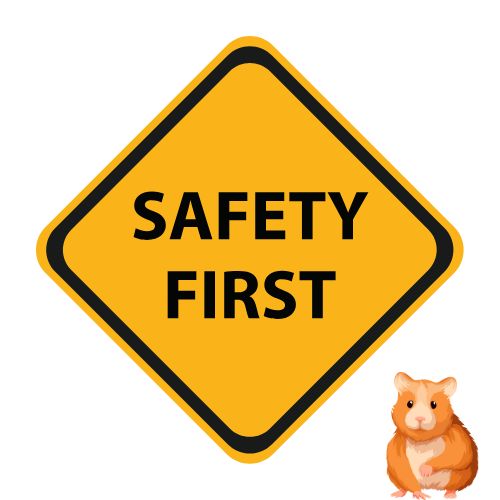Hamsters are known for their adorable appearance and playful nature, and one of the best ways to keep them entertained and mentally stimulated is by providing them with a maze to explore. A hamster maze is a fun and challenging environment that allows our furry friends to exercise their natural instincts and abilities.
Whether you’re a new or seasoned hamster owner, understanding the basics of these fun obstacle courses can help you create a safe and engaging space for your furry friend.
And building a hamster maze can be a rewarding experience that requires some creativity and planning. There are many different types of mazes to choose from, ranging from simple cardboard boxes to elaborate structures made of wood or plastic.
And while the design of your hamster maze will depend on your preferences and your pet’s personality, there are some important safety measures that you should keep in mind to protect your hamster from harm. By following some basic guidelines, you can create a fun and stimulating environment that your hamster will love exploring.
So let’s jump into the article and tell you what you need to know.
Key Takeaways
- Hamster mazes provide a fun and challenging environment for these small pets.
- Building a hamster maze requires creativity and planning, as well as attention to safety measures.
- By creating a safe and engaging space, you can help your hamster stay active and mentally stimulated.
Understanding Hamster Mazes
First, let’s talk about some of the high level concepts of a hamster maze, specifically their purpose and the different types available to you.
Concept and Purpose
As we’ve mentioned, mazes are a great way to keep all types of animals entertained and mentally stimulated. They are generally designed to provide a challenging environment for animals to navigate, explore, and exercise in.

The concept of a hamster maze is relatively simple. It involves creating an unknown structure that hamsters can navigate through. The structure can be made from a variety of materials, including cardboard, plastic, wood, or wire mesh. And it can be designed in a variety of shapes and sizes, depending on the available space and requirements.
The purpose of these types of mazes are to provide a unique and stimulating environment for hamsters to explore and scratch their endless curiosity itch. But they also provide a way for your furry friend to exercise that isn’t the same monotonous hamster wheel.
This type of exercise help prevent obesity and other health problems that can result from a lack of exercise, such as diabetes, as well as provide that mental stimulation we mentioned earlier.
Types of Hamster Mazes
There are several types of hamster mazes that can be created. These include:
- Cardboard mazes: These are simple mazes that can be created using cardboard boxes. They are easy to make and can be customized to fit the available space.
- Plastic mazes: These are more durable than cardboard mazes and can be purchased in a variety of shapes and sizes. They can also be connected to other plastic mazes to create a larger maze. Tubes and tunnels are a great way to create these types of plastic mazes.
- Wooden mazes: These are more durable than cardboard mazes and can be customized to fit the available space. They can also be painted or decorated to match the décor of the room. If you’re feeling a bit DIY, wooden is the way to go.
- Wire mesh mazes: These are more challenging than other types of mazes and can be created using wire mesh. They require more skill to create and can be dangerous if not constructed properly, so generally it’s not recommended since cardboard, plastic, and wood are better options.
- Playpen: An alternative to mazes is to use a playpen or other enclosed area to provide your hamster with a safe and stimulating environment. This allows your pet to explore and play without the constraints of a maze, and can be a good option for hamsters that are not interested in mazes or for owners who want to provide a larger play area.
Now that you know that there are several types of materials that can be used to create a maze, let’s talk about the actual process of building the maze, if you decide to go that route.
Building a Hamster Maze
If you’re going to build a maze, the first thing you need to do is create a checklist of all the necessary materials. At a bare minimum, here’s what you’ll need for this type of project:
| Materials | Quantity |
|---|---|
| Cardboard boxes | Multiple |
| Scissors | 1 pair |
| Ruler | 1 |
| Glue | 1 bottle |
| Markers | Multiple |
| Treats | Multiple |
Step-by-Step Guide
Once you have the materials prepared, you’ll want to design and build your maze. It’s important to have a handy step-by-step checklist, which we’ve provided below.
Time needed: 30 minutes
Here is a step-by-step guide of how to design and build a hamster maze:
- Plan the maze
Plan out the maze design on paper, ensuring that there are no dead ends and that the maze is not too complicated for the hamster to navigate.
- Collect maze materials
Collect cardboard boxes or you preferred maze material of various sizes and shapes.
- Cut holes
Cut holes into the boxes to create tunnels and pathways for the hamster to explore.
- Attach the walls together
Use glue to attach the boxes together, creating a maze structure.
- Decorate the walls
Once the maze is complete, decorate it with markers to make it visually appealing.
- (Optional) Add treats
Add treats throughout the maze to encourage the hamster to explore and navigate the maze.
Building a hamster maze can be a fun and rewarding activity for both the hamster and the owner. By following these steps and using the necessary materials, anyone can create a maze that will provide hours of entertainment for their furry friend.
Safety Measures in Hamster Mazes
When designing and building a hamster maze, safety should always be a top priority. Here are some important safety measures to keep in mind:

- Size of the Maze: The maze should be appropriately sized for the hamster. A maze that is too small can cause stress and anxiety for the hamster, while a maze that is too large can make it difficult for the hamster to navigate and find its way out.
- Materials Used: All materials used in the construction of the maze should be safe for hamsters. Avoid using materials that are toxic or could be harmful if ingested. It is also important to ensure that there are no sharp edges or corners that could injure the hamster. Hamsters will chew everything, including plastic, so anything you put in the maze should be safe for their consumption.
- Ventilation: The maze should have proper ventilation to ensure that the air inside is not stale or stagnant. Poor ventilation can lead to respiratory problems for the hamster.
- Accessibility: The maze should be easily accessible for cleaning and maintenance. This includes ensuring that there are no small crevices or areas that are difficult to reach.
- Supervision: It is important to supervise the hamster while it is in the maze. This will help ensure that the hamster does not become trapped or injured, and can also help prevent any potential escape attempts.
Benefits of Hamster Mazes
Let’s step back and take a few moments to talk about the actual benefits of a hamster maze, for both their physical and mental wellbeing.
Physical Benefits
Hamster mazes offer a range of physical benefits to hamsters. First, they provide a great source of exercise, which is essential for a healthy hamster. Running through the maze helps to improve their cardiovascular health and strengthens their muscles.

Additionally, the maze can help to prevent obesity and diabetes in hamsters, which can lead to a range of health problems and shorten their lifespan.
Mental Benefits
In addition to the physical benefits, hamster mazes also offer a range of mental benefits to hamsters. First, they provide a great source of mental stimulation, which is essential for a healthy and happy hamster. The maze can help to keep them mentally engaged and prevent boredom, which can lead to destructive behavior.
Furthermore, navigating through the maze can help to improve their problem-solving skills and spatial awareness. This can help to keep their mind sharp and improve their overall cognitive function.
While hamsters have small brains, it’s important to keep them challenged and always satisfy their curiosity.
Hamster Maze Challenges
Mazes are a great way to provide entertainment for your furry little friend. However, as with any activity, there are some challenges that can arise. This section will discuss the most common challenges that hamster owners may face when setting up and using a maze, as well as solutions and alternatives to consider.
Maze Design
One of the most common challenges with hamster mazes is designing a maze that is both challenging and safe for your pet. Some maze designs may be too difficult for your hamster to navigate, while others may not provide enough of a challenge.

Additionally, some designs may have sharp edges or other safety hazards that could harm your pet.
To address these challenges, it’s important to consider the size and abilities of your hamster. A maze that is too large or complex may be too challenging for your pet to navigate, while a maze that is too simple may not provide enough stimulation.
Maze Maintenance
Another challenge with hamster mazes is keeping the maze standing upright and clean. Mice and hamsters are known to chew on things, and a maze made of cardboard or other materials may not last very long.
Additionally, mazes can become dirty over time, which can be a health hazard for your pet.
To address these challenges, it is important to choose a maze made of durable materials that can withstand chewing and other wear and tear. You should also be cleaning the maze regularly to prevent the buildup of dirt and bacteria.
Advanced Hamster Maze Designs
More advanced mazes and designs are perfect for hamster owners who want to challenge their pets and provide them with a fun and stimulating environment. These types are designed to be more complex and challenging than traditional hamster mazes, requiring more skill and agility from your furry friend.
One popular design is the multi-level maze. This generally features multiple levels that your hamster can climb up and down, providing a vertical challenge for your furry friend. The maze can also include tunnels and other obstacles that your hamster must navigate through to reach the end.
Another popular design is the obstacle course maze. This maze features a variety of obstacles that your hamster must navigate, such as jumps, tunnels, and balance beams. This design is great for hamsters who are particularly active and enjoy a challenge.
When designing one of these more elaborate setups, it’s important to keep safety in mind. Make sure the structure is sturdy and secure. It’s also important to supervise your hamster while they are navigating the maze to ensure they do not become stuck or injured.
Frequently Asked Questions
Here are a few of the most commonly asked questions about hamster mazes:

How do you build a hamster obstacle course?
Building a hamster obstacle course can be a fun and rewarding experience. The first step is to plan out the course and decide on the obstacles you want to include. You can use items such as cardboard boxes, toilet paper rolls, and tunnels to create a fun and challenging course for your hamster.
What materials do you need to make a hamster maze?
To make a hamster maze, you will need materials such as cardboard boxes, paper tubes, tunnels, and other items that your hamster can climb on or through. You can also use treats to encourage your hamster to explore the maze.
What are the benefits of a hamster maze?
A hamster maze can provide your pet with mental stimulation and exercise. It can also help to prevent boredom and keep your hamster active and healthy.
What is the best way to introduce a hamster to a maze?
The best way to introduce your hamster to a maze is to start with a simple course and gradually increase the difficulty level. You can also use treats to encourage your hamster to explore the maze.
How can you make a hamster maze more challenging?
To make a hamster maze more challenging, you can add more obstacles or make the course longer. You can also create different levels or sections that your hamster has to navigate.
Do hamsters enjoy obstacle courses?
Many hamsters enjoy obstacle courses and find them to be a fun and stimulating activity. However, it is important to monitor your hamster and make sure that the course is safe and not too difficult for them to navigate.
Conclusion
In conclusion, hamster mazes are an excellent way to provide entertainment and exercise for pet hamsters. Through the use of various materials, such as cardboard, wood, and plastic, owners can create a variety of maze designs to challenge their hamsters and keep them mentally stimulated.
When creating these mazes, it’s important to consider the size and abilities of your hamster. Small hamsters may struggle with mazes that have high walls or narrow passages, while larger hamsters may require more space to move around comfortably.
Overall, hamster mazes can be a fun and rewarding activity for both owners and their pets. By providing a stimulating environment, owners can help their hamsters stay healthy and happy. With a little creativity and effort, anyone can create a unique and challenging maze for their furry friend to explore.